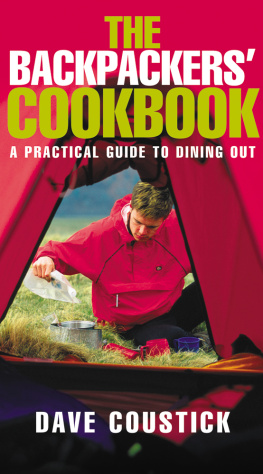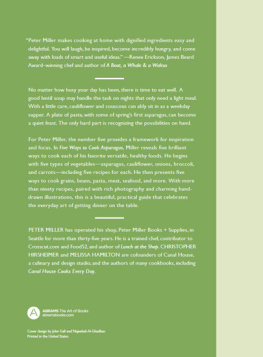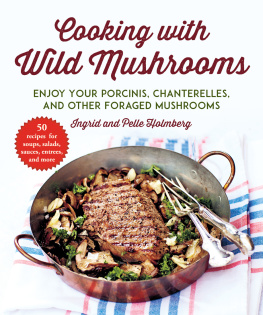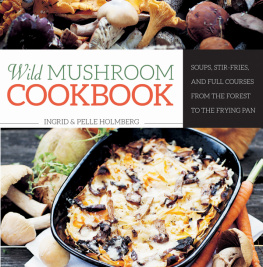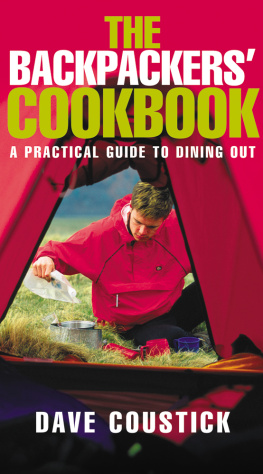The In Pinn is an imprint of
Neil Wilson Publishing Ltd
www.nwp.co.uk
Dave Coustick, 1996, 1998, 2011
Foreword Nick Nairn, 1998, 2011
The author asserts his moral right to be identified as the author of the work.
A catalogue record for this book is available from the British Library.
First published in 1996.
Print edition ISBN: 978-1-897784-38-9
Ebook ISBN: 978-1-906476-82-3
CONTENTS
FOREWORD
O NE of the great things about exercise, such as a hard day's walking in the hills, is that it gives you a good appetite and the excuse to indulge yourself. If the thought of dinner while backpacking, or on any other camping or cycling trip, conjures up visions of sausage and beans or a dehydrated packet of soup, think again. There is no reason why you cannot produce some exciting and appetising meals on your camp stove. With the right forethought and a few well-chosen ingredients, the possibilities are legion.
The philosophy in my cooking is to use only the freshest ingredients. This is important with any meal, wherever it is cooked. If that meal is at the beginning of a trip, carry at least some fresh items. Save the ultra-lightweight dried stuff, if weight dictates the need for this, for later in your tour.
In theory one can live off the land, but few of us have the combination of skill, patience and confidence to do this. It is not the intention of The Backpacker's Cookbook to enable you to survive in this way, but it does provide a comprehensive selection of recipes that are simple to prepare, even on a camping stove, yet give scope for nutritious and tasty fare.
Adding that sprinkle of parmesan, a handful of fresh herbs, a dash of wine or liqueur gives that extra touch to your evening meal. With The Backpacker's Cookbook you can match your magical meal to the splendid scenery as you sit in the evening sunshine.
Nick Nairn
INTRODUCTION
W hat can be better than camping out in a magnificent mountain setting, in good weather, and enjoying a gourmet meal, perhaps washed down with a glass or two of wine? You will have to choose your surroundings, take a chance on the weather, but this book will leave nothing to doubt for that meal!
Not all the recipes should be considered as too exotic and I have included everyday dishes as well. But from time to time it is great to sample something a bit more unusual. What is more, some of the best meals need not be expensive to prepare. Careful use of local ingredients which are in season is the key here. That may mean buying ripe tomatoes, a large lettuce and fresh olives to make a simple salad in the South of France or some other Mediterranean location. Or it may be that you have caught a fresh trout, or picked some wild mushrooms. These simple ingredients can never be improved upon.
There are several things which set camping cookery apart and each of these can present a few difficulties. Each of these topics is covered with advice and techniques. The problems include; difficulty in regulating the stove, limited amount of fuel, limited number of pans, keeping food fresh and carrying food.
The biggest limitation to cooking for backpackers and campers alike is normally the type of stove used and specifically the lack of an oven and of multiple burners. Camping can vary from being on a smart campsite with the car next to you to backpacking into the middle of nowhere, with a wide variety of situations in between. I have tried to cover the full range of backpacking and camping but some recipes are clearly more suited to one situation than another. Many of the recipes can be used just about anywhere, sometimes with a bit of adaptation. Cooking in a well-equipped caravan or at a campsite providing a comprehensive kitchen, such as is quite common in New Zealand, has not been specifically catered for. Obviously, if you have such facilities you can extend your repertoire to many of the standard meals you might cook at home. Whichever path you decide to take, I hope you find the results both satisfying and rewarding.
When I first had the idea for this book I had not realised how few were the number of recipes in my regular repertoire. In carrying out my research I have acquired many more and had great fun in trying them out. Many of the recipes and ideas have originated from friends and I must thank them all, in particular Karen Beattie, Lis Briggs, Graham and Caz Dudley, Neil and Rosella Hardy, Kevin Jackson, Liz Jolley, Wendy Johnston, Dave Lecore, Eileen Lilley and Nigel Charman, Nick Nairn, Adrian Parsons, Carl Pryce and Rosie Hickey, David and Barbara Pickford, Steve Thomas and Tony Williams.
Dave Coustick
Bridge of Allan, 2011
1
STOVES AND COOKING UTENSILS
T here are several types of stove available to the backpacker and camper. Each type has some good points and some disadvantages. Also you may already have one particular stove and not wish to spend money to change it. I would say that any of the recipes can be cooked on any of the stoves, but some are easier than others.
METHS-BASED STOVES
The Trangia stove is very simple to use, extremely stable and works well in windy conditions. It is also quite easy to regulate the temperature. The main problems are that it is fairly slow and uses quite a large volume of fuel. Meths can also be quite difficult to locate in some parts of the world.
GAS STOVES
There are many different makes and designs on the market, ranging from some very small ones which make ideal backpacking stoves, to some over-elaborate devices. Easy to use and regulate, they can also put out a high amount of heat. Some of the smaller ones can be a bit unstable and care must be taken in their use. There are two main standards for gas cylinders, the screw-on type as used by Coleman, and the blue push-on type from Camping Gaz (though this company has now introduced an additional type which can be removed and refitted.)
The screw-on type is more versatile and the best stoves seem to be ones with that fitting. It can however be difficult to get these gas cylinders in some areas. The other problem with gas is that butane does not perform well at all in cold weather. The Coleman range of cartridges are also available with a propane-butane mix, and this is well worth getting for anything other than summer use.
PETROL/COLEMAN FUEL STOVES
There are a number of these stoves on the market, and some will also run on paraffin (see for more information on fuels).
PARAFFIN STOVES
Some of the Peak One stoves, the MSR, XGK and the International version of the Whisperlite also run on paraffin with a slightly reduced heat output. The comments above apply.
The other main brands of paraffin stove are the Primus and Optimus. These were the original camping stoves and are still very effective. However they are relatively big and heavy and are a bit fiddly compared to gas. The other disadvantage of paraffin is that it smells and takes time to dissipate.
COOKING UTENSILS
Pots and pans take up a lot of space and can be heavy, so the selection is normally quite restricted. Most recipes require one large pan for pasta/rice etc. and a second pan for the sauce or main dish. A deep frying pan is the best all-round selection for this. There is a wide range of camping cookware on the market. Aluminium is the most common choice but this has some limitations, and is probably the most prone to burning food. Non-stick pans can be bought, though I have had a problem with some being equally non-stick on the outside. These sit happily on the stove until the contents are hot, or worse still, ready to eat, and then slide off and deposit the contents in the grass! If using a Trangia stove this is not a problem as the pans sit inside the body of the stove.

